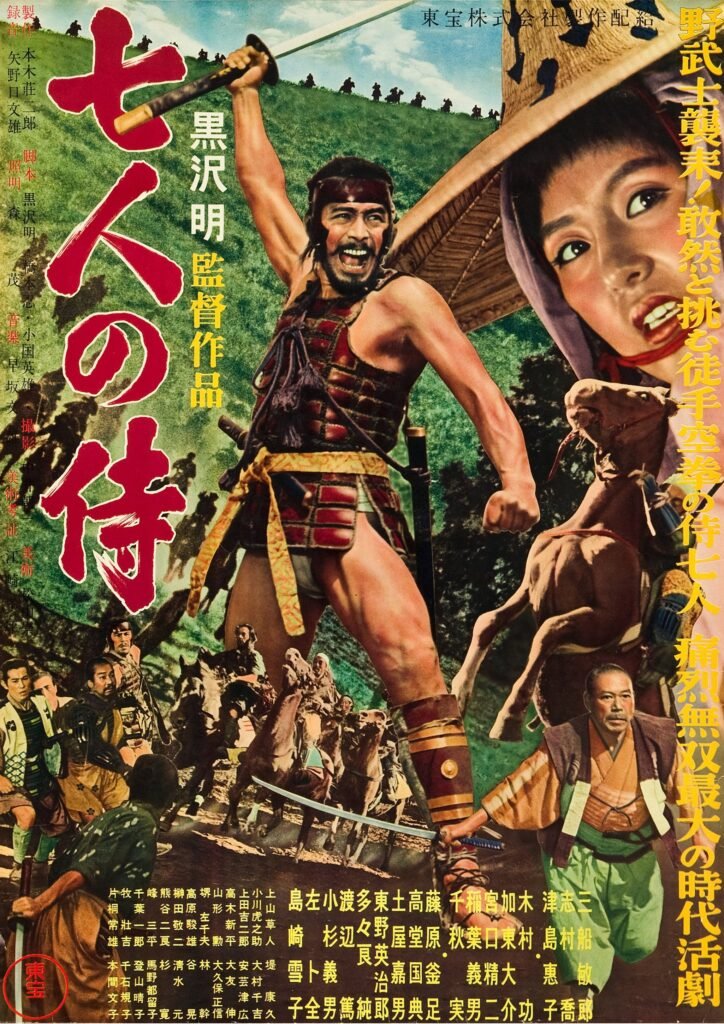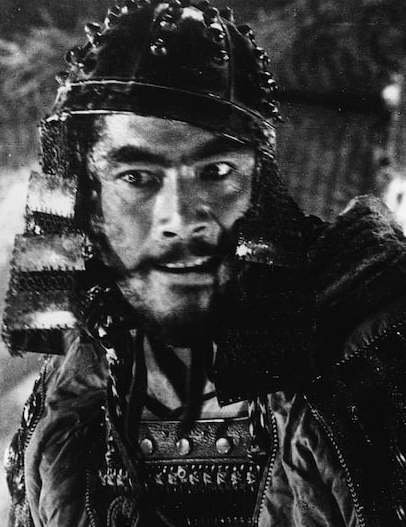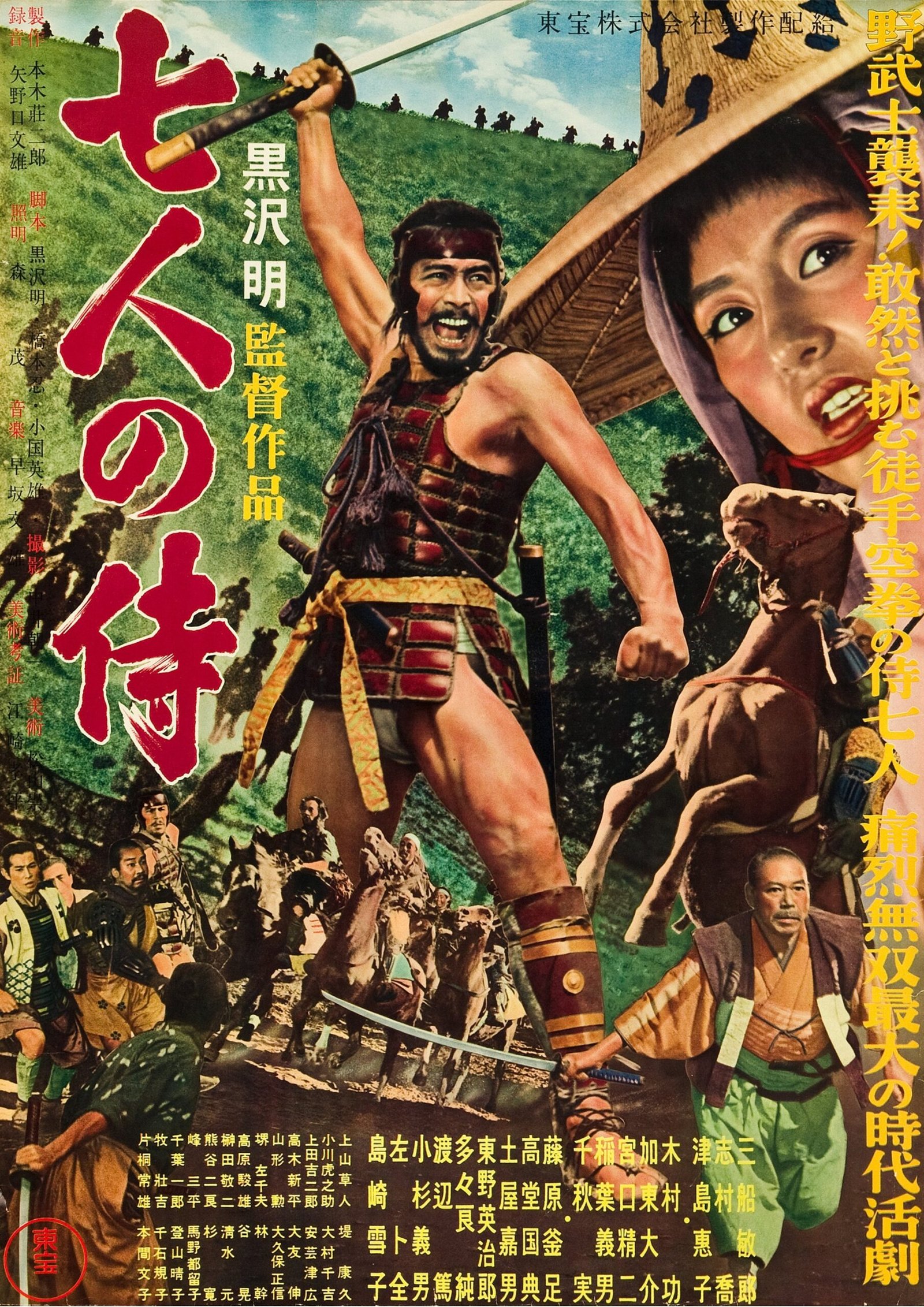
Seven Samurai
Japan, 1954
Director: Akira Kurosawa
Screenwriters: Akira Kurosawa, Shinobu Hashimoto, Hideo Oguni
Genre: Chambara
Soundtrack composer: Fumio Hayasaka
Editing: Akira Kurosawa
Production company: Toho
Main actors:
Toshirō Mifune (Kikuchiyo)
Takashi Shimura (Kambei Shimada)
Yoshio Inaba (Shichiroji)
Seiji Miyaguchi (Kyuzo)
Minoru Chiaki (Heihachi)
Daisuke Katō (Shimada)
Kamatari Fujiwara (Manzo)
Keiko Tsushima (Shino)
Yoshio Tsuchiya (Bandit)
Kokuten Kōdō (Village elder)
Plot
Ferocious bandits terrorize vast rural areas in 16th century feudal Japan. They steal their crops from the humble peasants, who, stricken by misery, are on the verge of despair. They no longer have any rice and a famine looms menacingly over them. The state authorities do nothing to protect them. They feel helpless and abandoned. Some even talk of committing suicide. Only a few seem to have the resolve and the guts to stand up to the outlaws ravaging the region. The immense mass of the locals show a pusillanimous and resigned character. They all whine and lament, but are unwilling to fight the enemy. They prefer to take their own lives rather than die in combat…
Finally, the villagers decide to ask the old patriarch, an old miller named Gisaku, for advice. He decides that the only solution is to fight the bandits. But since they themselves are incapable, lacking any experience with weapons, they will have to hire samurai. They will have to be recruited from among the poorest samurai: the wandering ronin, unemployed knights-errant without a lord to serve. The task of getting the cooperation of experienced warriors will be very difficult, because the poor villagers have nothing to pay them, and can only appeal to their goodwill and compassion. The only thing they can offer them is the little rice they have left.
Emissaries from the village leave for neighboring places to spread the word that they are looking for protectors. In another village they find that a bandit has taken a baby hostage, barricading himself in a thatched cottage. The peasants, about 20 in number, dare not intervene. But a veteran samurai passing by decides to rescue the child. To do so, he had his head shaved with the intention of looking like a priest. He approaches the hut where the bandit is hiding, carrying two rice balls, and when the criminal is about to take them, he acts swiftly, killing him and saving the child.
The samurai, named Kambei, is cheered as a hero and several young men who witnessed his deed ask to join him. Among them is the young Katsushiro, who insists on becoming his disciple. Also a colorful individual who always carries a giant sword resting on his shoulder begins to follow him.
When Kambei learns that the nearby peasant village needs help against bandits, he resolves to create a small troop of impoverished samurai and come to the rescue. To select the best ronin, Kambei tells Katsushiro to hide by the gate with a stick and beat the candidate as he is about to enter. Only if the aspirant manages to swiftly dodge the attack will he be a worthy warrior for the mission. Thus begins to take shape a small group of samurai: Shichiroji, Kambei’s old friend whom he meets by chance; Heihachi, an expert at chopping wood with an axe; Gorobei, a great archer and strategist; Kyuzo, who initially refuses the offer to join the group but changes his mind. Kyuzo is a hard ronin with a somber look, taciturn and a great fighter. That makes five of them, counting Kambei. Kambei finally agrees to take Katsushiro under his protection. Despite his inexperience and youth, he is accepted into the group. One night another candidate appears, completely drunk: It is the histrionic ronin with the giant sword on his shoulder, who had also witnessed the rescue of the baby by the “monk” Kambei. The alcoholic character, excited by too much sake, claims that he too is of samurai lineage and wants to be part of the team. He even has a scroll with a family tree to prove his ancestry. But Kambei and the others burst out laughing when they see that the Kikuchiyo mentioned in the scroll is supposed to be 13 years old, “You look very old for your age,” Kambei comments jokingly. Kikuchiyo is outraged when his ruse is discovered. But the next morning, he still continues to follow the group – for he wants to be the seventh samurai.
Meanwhile, in the village, the peasants no longer feel safe at the news of the approaching samurai. Many of them fear not only the bandits, but even those who will have to protect them against them. The villagers’ irrational cowardice is embodied in the character of Manzo, who forces his beautiful daughter Shino to cut her hair – to look like a boy, as he fears the samurai might rape her.
When the seven ronin arrive in the village, they are surprised to find the streets deserted. The villagers, instead of coming out to welcome them, hide from them in their homes. Kambei and his men, surprised by this behavior, go to see old Gisaku. He tells them not to be offended, because the peasants, of an excessively gentle and retiring nature, are afraid of everything. At that moment, the alarm sounds: the bandits are approaching! Panic spreads in the village, all the villagers come out of their houses and run frantically through the streets… But it was all just a joke by Kikuchiyo: he had raised the alarm, thus achieving what he had intended: the peasants came out of their houses. The other samurai reacted with hilarity at the witty witticism, which also served to expose the atavistic cowardice of the villagers.
Now the samurai begin to devise a plan for the defense of the village. The bandits could attack at any moment and we must be prepared…

Comment
The master Akira Kurosawa renewed with this wonderful feature film the classically Japanese genre of the chanbara or jidaigeki, thus setting the precedents and the basis for the samurai films that would appear in the following years. Kurosawa’s films are the best known of their subject matter in the West, but in the following decades would come more chanbara masterpieces (although with a quite different style) by other directors such as Kenji Misumi (Zatoichi saga, Lone Wolf hexalogy, Hanzo the razor…) or Hideo Gosha (“Sanbiki no samurai”, 1964 or “Hitokiri”, 1969).
“The Seven Samurai” is a classic in the history of cinema in general, and not only in Japan. The film, despite its long running time of more than three hours and having been filmed more than six decades ago, never becomes tiresome at any time and is fresh and entertaining; especially thanks to the motley cast of characters – each with a distinct personality, so that it is always easy to identify and empathize with at least one of them.
Undoubtedly the most memorable of the seven is the buffoon Kikuchiyo (although that was certainly not his real name, but only the one that appeared on the genealogical scroll). The unforgettable and eccentric ronin, whose peasant origins are revealed during the film, was played by Toshiro Mifune, and this was the role that would catapult him to stardom. Kurosawa authorized Mifune to shape his character himself, improvising during the filming. Later on, the talented actor would continue to collaborate with Kurosawa (as in “Yojimbo”, 1961). In the group of brave samurai also stand out the young and dreamy Katsushiro, who will fall in love with the attractive peasant girl Shino (despite the haircut his father imposed on him), or the icy martial artist Kyuzo – who is undoubtedly the prototype of the lone ronin that would later proliferate in the jidaigeki genre, being thus a forerunner of the Lone Wolf Ogami Itto, for example. The benign leader Kambei is a model sensei, who always has wise advice to give to his comrades: “It is more difficult to defend than to attack”, or “In a battle you should never make individual decisions”. Under Kambei’s rule, Sun Tzu’s art of war is combined with the noble principles of Bushido.
The servile and cowardly cowardice of the peasants is also masterfully portrayed, and this would become a recurring theme in this type of cinema (as in “Zatoichi umi o wataru”/“The Pilgrimage of Zatoichi”, 1966, by Kazuo Ikehiro; or in the aforementioned “Sanbiki no samurai”/“Three Samurai Outside the Law”, 1964, by Hideo Gosha).
The film has also greatly influenced Western filmmakers: “The Magnificent Seven” (John Sturges, 1960) is a western remake of “The Seven Samurai”. John Milius has stated that the final battle scene in the burial mounds of “Conan the Barbarian” (1982) was inspired by the choreographed fights of Kurosawa’s masterpiece.
Get Seven Samurai HERE!
(This is an affiliate link. I may earn a commission if you purchase through these link, at no extra cost to you. As an Amazon Associate, I earn from qualifying purchases.)

